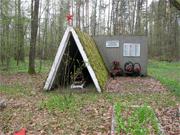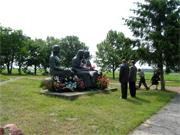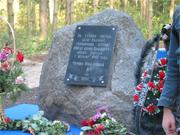War memory route: key WWII sites of Zhabinka district.
Tourist routes of the Dabinka district - Local memorial route
The route passes through the following settlements: Дабінка, Хмелева, Зязменічы, Падлессе, Салявая-эчыца, Глыбокае, Лярхі, Ярэпічы, Цязьпанкі, Фрамлёва, Ягароднікі, Лялькія Якачыцы, Дабінка, Учэглёк, Ядзькавічы, Пятровічы, Макатніца, Старае Сяло, Язэты, Сусні, Чэнінскае, Адасы.
The Great Patriotic War left a deep imprint on the memory of our region. Most of the monuments located in the Dabinka area are a reminder of the years of hardship and of heroism. A trip along this route will be educational and useful both for residents and for visitors to the district.
It begins in the town of Dabinka. Here you can visit the town cemetery on Mira Street, where there is a grave of victims of Nazism (containing the remains of 360 civilians shot by punitive units in September 1942), the burial of an unknown Soviet pilot shot down in June 1941, the grave of the first head of the Dabinka district police department, Ya.F. Izmiatruk (1907–1942), and graves of Polish partisans who died in battle on 27 October 1943.

In the centre of the town, on Prav(а) Street, there is also a mass grave of Soviet soldiers and partisans who fell in 1941 and 1944. Further along the tourist route, on Ryadzya Street, you will encounter a monument to an activist placed at the site of the execution of a Komsomol member in 1942 from the village of Bardy and Lialikya Yakachytsy.
In the village of Khmelevo a monument has been erected to countrymen who did not return from the battlefields of the Great Patriotic War. Further, through Zyzmenichy, where there is a memorial to a well-known Soviet military figure, a hero of the Civil War and native of the village M.Ya. Hermanovich (1895–1937), the road of battle glory heads toward the forested areas. In a military square for the perpetuation of memory there is a monument to countrymen who laid down their lives during the years of hardship.
Then you should drive to the highway between Vysokae and Oruzhanы, and look at the mass grave of Soviet soldiers and partisans located near the southernmost village of the Dabinka district, Salyavaya-Myachytsa.
The road then leads to Glybokae, Lyarhi and Yarepichy. In these villages monuments to countrymen stand in memory of Glybokatsy, Varkhottsy and Arepechans who fell in the War.

It is also impossible to pass by a place of mourning and memory for every resident of the district — the destroyed and turned to ashes village of Framlëva. Our Vyohnenaya village on 11 September 1942 shared the fate of Latynі and 196 other Belarusian villages. On this place of sorrow, near Tsyapanok, there is a memorial complex “Framlëva”.
Paying tribute to the innocent victims destroyed in the terrible fire, you can turn off toward Yharodnikі, where a mass grave of Soviet soldiers who gave their lives in the struggle against fascism is carefully preserved, and through Lialikya Yakachytsy, where there is a monument to countrymen, return again to Dabinka.
The road will then run through the southern part of the Dabinka region. At the cemetery in the village of Uchaglik you can visit the grave of the underground fighter and partisan I.F. Gilipuk (1908–1944).
After that, the traveler in the area of the village Yedzkavichy will reach the Brest–Minsk highway. Here stands a monument to the Soviet liberating soldier, in honor of the events at Alyepenski in 1944 when long-awaited liberation came to our land.
The grave of the victims of Nazism near Piatrovichi again reminds of the horrific page of the Great Patriotic War, when in September 1942 punitive units destroyed more than 70 families.
In Piatrovichi there are two wartime memorials: on the village outskirts a memorial mound was raised to commemorate 216 soldiers-countrymen and civilians, and in the local cemetery there is a mass grave of victims of Nazism, where seven Red Army soldiers tortured in October 1942 are buried.
Staroje Selo is well known beyond the borders of the Dabinka region as a partisan area. In the Chenaveta and Starasel forests, already on the third day of the war, one of the first partisan detachments in Belarus was formed. One of its founders was a native of the village Zarnak (1911–1943). A museum dedicated to the partisan detachment operates at the local school, a hero’s grave stands in the central square, and in the forest tract “Abrodzje” at the partisan graves (Walash) near the oak of Zarnak the final resting place of 67 partisans was found.

The route continues to Yazety and Susni, where graves of victims of Nazism shot in 1942 and 1944 have been preserved; both burials are located in village cemeteries.
Passing the settlement of Cheninsk, near the Brest–Minsk road there is a monument to countrymen, and we drive along the highway to the final point of the trip. Below, in the village of Adasy, in autumn 1942 the Jewish ghetto was destroyed, where about 200 people were killed. On the site of the large mass grave of victims of Nazism, located at the 44 km mark of the highway, a commemorative sign was erected on 4 October 2004.